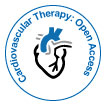An Example of Controversies on Anti-fibrosis Therapies in Cardiovascular Diseases: Transforming Growth Factor β1
Received: 14-Dec-2015 / Accepted Date: 14-Dec-2015 / Published Date: 29-Dec-2015
Keywords: Transforming growth factor; hypomorphic mutations
78740Transforming growth factor β1 (TGFβ1) is the pleiotropic cytokine, the functions of which are diverse and often contradictory. In oxidative stress-associated cardiovascular diseases including hypertension, diabetes mellitus, and ischemia-reperfusion injury and in normal aging process, the expression of TGF β1 is increased. TGF β1 induces the expression of the genes involved in the accumulation of extracellular matrix (ECM) [1]. ECM gives mechanical stiffness to the heart and vasculature to let them function properly, but its excessive accumulation could impair cardiac diastolic function and diminish arterial flow reserve. Furthermore, the higher than normal expression of TGF β1 enhances ECM accumulation in the renal mesangium. The resultant reduction of open capillary area in the glomerulus leads to the decrease in glomerular filration rate and chronic renal failure [2].
In addition, the TGF β signaling has recently been demonstrated to play a pivotal role in maintaining the structural integrity of the aorta. Aortic aneurysm and dissection are components of the vascular phenotype of Marfan syndrome. In humans with Marfan syndrome type 1, which is caused by mutations in the fibrilin-1 gene (FBN1) [3], circulating concentrations of TGF β1 [4] and the expressions of TGF β1 in primary-cultured vascular smooth muscle cells are increased [5]. In the mouse model of Marfan syndrome, angiotensin type 1 receptor antagonist losartan has been shown to be effective to decelerate the growth of thoracic aortic aneurysms, via suppressing TGFβsignaling [6].
The Loeys-Dietz syndrome (LDS), an autosomal dominant human syndrome caused by mutations in both type1 and type2 TGFβreceptor genes (TGFBR1 or TGFBR2), is characterized by aggressive aneurysms in the ascending aorta [7]. Immunoreactivity of phosphorylated Smad2, an intracellular signaling molecule downstream of TGFβreceptors, is increased in the aortic wall of patients with LDS [8], suggesting that the mutations causing LDS are hypermorphic. However, a later study demonstrated that the LDS-associated mutation in the TGFβreceptor gene instead attenuates canonical TGFβ signaling in cultured human embryonic kidney cells [9]. Current understanding is that the hypomorphic mutations for the TGF β receptor genes could compensatorily stimulate its downstream signaling in patients with LDS.
These findings indicate that TGF β1 is a harmful cytokine that is induced in many cardiovascular diseases, and a number of pharmaceutical agents have already been developed for this purpose. However, recent studies have suggested that suppressing TGF β1 also causes devastating cardiovascular diseases. For instance, Marfan syndrome type 2 is associated with a loss-of-function mutation in the TGF β receptor 2 gene (TGFBR2) [10]. Recently, it has been discovered that loss-of-function mutations in a ligand TGFB2 causes aneurysms and dissections in the ascending aorta and the sinus of Valsalva [11,12].F
Mice completely lacking TGF β1 prematurely die from systemic inflammatory disease around weaning [13]. Cardiomyocyte/smooth muscle-specific disruption of type 2 TGF β receptor gene (Tgfbr2) causes not only wall thinning and rupture of the aorta, but also heart defects including ventricular myocardium hypoplasia in mice [14]. Likewise, postnatal smooth muscle-specific disruption of Tgfbr2 also dilated and dissected thoracic aorta [15]. Mice with genetic insufficiency of TGF β1 exhibit primary aldosteronism and marked impaired dieresis and natruresis, which could exacerbate the cardioaortic dilatative changes [16].
Despite TGF β1 has double-edged effects in cardiovascular diseases; it seems that the suppression of TGF β1 causes more life-threatening outcomes than its stimulation does. Although anti-TGF β1 therapies could be useful to reduce pathological changes in cardiovascular ailments when performed in tissue and/or time specific manners, preventing the conditions in which TGF β1 has to be induced may be more practical to improve general prognosis of cardiovascular diseases.
References
- Kakoki M, Oleh MP, Catherine MH, Hirofumi TJohn RH,et al. (2013) Primary aldosteronism and impaired natriuresis in mice underexpressing TGFbeta1. ProcNatlAcadSci USA 110: 5600-5605.
Citation: Kakoki M (2015) An Example of Controversies on Anti-fibrosis Therapies in Cardiovascular Diseases: Transforming Growth Factor β1. Cardiovasc Ther 1: e101.
Copyright: © 2015 Kakoki M. This is an open-access article distributed under the terms of the Creative Commons Attribution License, which permits unrestricted use, distribution, and reproduction in any medium, provided the original author and source are credited.
Share This Article
şÚÁĎÍř Journals
Article Usage
- Total views: 10623
- [From(publication date): 2-2016 - Nov 22, 2024]
- Breakdown by view type
- HTML page views: 9890
- PDF downloads: 733
